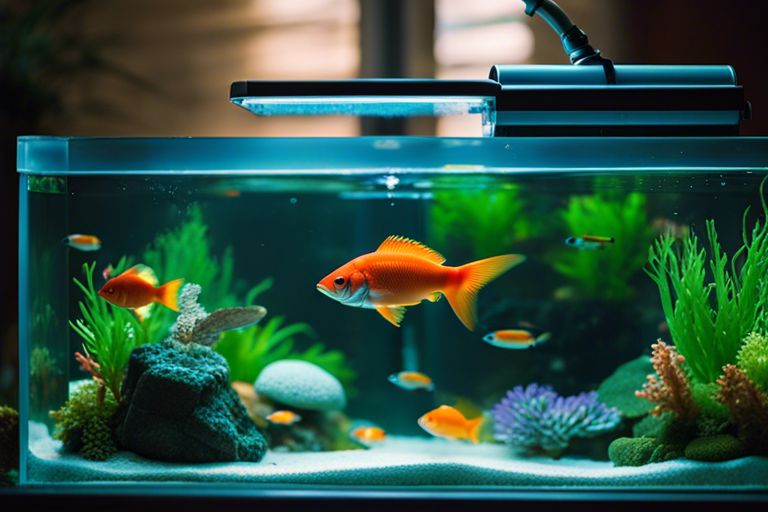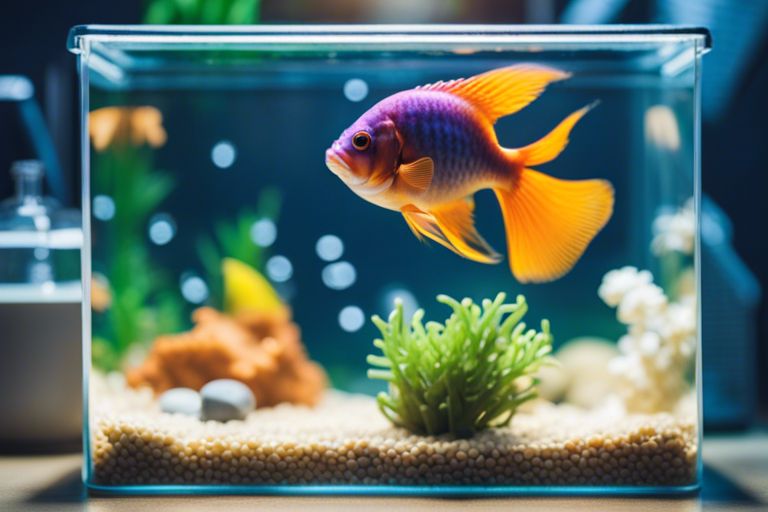There’s nothing quite as mesmerizing as a crystal-clear fish tank brimming with vibrant aquatic life. However, to maintain a healthy and thriving environment for your fish, regular cleaning is crucial. In this comprehensive guide, we will walk you through the step-by-step process of properly cleaning your fish tank to ensure your underwater friends stay happy and healthy. From choosing the right cleaning supplies to establishing a routine maintenance schedule, we’ve got you covered with all the expert tips and techniques you need to keep your fish tank sparkling clean.

Types of Fish Tank Cleaning
To maintain a healthy environment for your fish, it is crucial to understand the different types of fish tank cleaning methods available. Recognizing the right approach for your tank can lead to cleaner water, healthier fish, and a more enjoyable aquarium overall.
| Routine Maintenance | Deep Cleaning Methods |
| Biological Cleaning Tactics |
Routine Maintenance
Assuming you have a regular schedule for cleaning your fish tank, routine maintenance tasks play a vital role in keeping your aquarium clean and balanced. This includes actions such as partial water changes, debris removal, and filter maintenance to prevent the buildup of harmful substances that can harm your fish.
Deep Cleaning Methods
Assuming your fish tank requires a more thorough cleaning, deep cleaning methods are crucial to remove stubborn algae, waste, and other contaminants that can affect water quality. Understanding the proper techniques for deep cleaning will help you maintain a pristine environment for your fish and prevent any potential health issues.
When performing deep cleaning, it is crucial to remove all decorations and gravel to thoroughly clean the tank.
Biological Cleaning Tactics
There’s more to cleaning a fish tank than just scrubbing surfaces. Biological cleaning tactics involve utilizing beneficial bacteria to break down waste and maintain a healthy nitrogen cycle in the tank. By understanding the role of these beneficial bacteria, you can create a self-sustaining ecosystem that reduces the need for frequent water changes and chemical additives.
Certain fish species, like catfish and plecos, can also contribute to biological cleaning by feeding on algae and waste in the tank.
Cleaning
Cleaning your fish tank is not just about aesthetics – it is a crucial aspect of maintaining a healthy environment for your aquatic pets. By incorporating a combination of routine maintenance, deep cleaning methods, and biological cleaning tactics, you can ensure that your fish tank remains clean, balanced, and thriving for years to come.

Factors Affecting Cleaning Frequency and Techniques
Little factors can greatly impact the frequency at which you need to clean your fish tank and the techniques you should use to maintain a healthy aquatic environment. Understanding these factors is crucial for the well-being of your fish and the overall maintenance of your tank.
Tank Size and Location
Factors such as the size of your tank and its location in your home can influence how quickly it gets dirty and how frequently it needs cleaning. Larger tanks generally require less frequent cleaning compared to smaller tanks, as they have more water volume to dilute waste products. Additionally, tanks placed in areas with high sunlight exposure may experience faster algae growth, requiring more frequent cleaning to maintain water quality.
Fish Species and Stocking Density
Location plays a key role in determining the cleaning frequency and techniques needed. Fish species that produce more waste or are larger in size may require more frequent cleaning to remove excess waste and uneaten food. Similarly, tanks that are overstocked with fish can lead to a higher accumulation of waste, necessitating more frequent cleaning to prevent water quality issues.
Types of Filtration Systems
Plus, the type of filtration system you have in your tank can also influence cleaning frequency and techniques. Different filtration systems remove waste and impurities at varying rates, affecting how often you need to clean your tank. Understanding the pros and cons of each filtration system is important for maintaining a clean and healthy environment for your fish.
- Types of Filtration Systems remove waste and impurities at different rates.
- Regular maintenance of the filtration system is crucial for optimal performance.
- Proper filtration helps in maintaining water quality and reducing the frequency of tank cleaning.
- Some filtration systems may require more frequent cleaning than others.
- Choosing the right filtration system for your tank is important for the health of your fish.
| Types of Filtration Systems | Pros and Cons |
| Mechanical Filtration | Traps debris but requires regular cleaning. |
| Biological Filtration | Breaks down harmful ammonia but needs time to establish beneficial bacteria. |
| Chemical Filtration | Removes impurities but may need frequent replacement of filter media. |
| UV Sterilizers | Kills algae and harmful microorganisms but may increase maintenance costs. |
| Sponge Filters | Gentle on fish but may require more frequent cleaning. |
After considering these factors, you can develop a cleaning routine that suits the specific needs of your tank and its inhabitants. Consistent maintenance is key to a thriving aquatic ecosystem, so be sure to monitor these factors regularly to keep your fish happy and healthy.

Step-by-Step Guide to Fish Tank Cleaning
Pre-Cleaning Preparations and Tips
| Preparation | Tips |
| Assemble all necessary cleaning supplies | Have a bucket, algae scrubber, water siphon, and clean sponges ready |
| Turn off all electrical equipment | Unplug filters, heaters, and lights before starting the cleaning process |
| Prepare new water for the tank | Ensure the water is at the right temperature and treated with a dechlorinator |
- Before starting the cleaning process, make sure to feed your fish lightly or remove them from the tank temporarily to avoid excess waste during cleaning.
- Perceiving any issues like cloudy water, unpleasant odors, or excessive algae growth can help you address underlying problems during the cleaning process.
Step-by-Step Cleaning Process
| Steps | Tips |
| To start, remove decorations and artificial plants | Place them in a bucket of tank water to preserve beneficial bacteria |
| Use an algae scrubber to clean the glass surfaces | Scrub gently to avoid stressing fish or damaging the tank |
| Perform a water change by siphoning out debris | Aim to remove 10-25% of the water to maintain water quality |
StepbyStep: After completing the water change, clean the filter media in the old tank water to preserve beneficial bacteria that aid in biological filtration. Lastly, refill the tank with treated water and reacclimate your fish before turning the equipment back on.
Pros and Cons of Various Cleaning Techniques
| Technique | Pros and Cons |
| Chemical Cleaners | Effective at removing tough algae and grime, but may harm fish if not used properly. |
| Natural Cleaners | Gentler on fish and the environment, but may not be as strong for tough cleaning tasks. |
| Manual Tools | Provides a hands-on approach for targeted cleaning, but can be time-consuming and tiring. |
| Automated Tools | Efficient and convenient for regular maintenance, but may not be as thorough as manual cleaning. |
Chemical vs. Natural Cleaners
To maintain a clean fish tank, you have the option of using chemical cleaners or natural alternatives. Chemical cleaners are effective at eliminating tough algae and grime, but they can be harmful to your fish if not used carefully. On the other hand, natural cleaners are gentler on your aquatic pets and the environment, although they may not be as powerful for stubborn cleaning tasks.
Manual vs. Automated Tools
In the matter of cleaning your fish tank, you can choose between manual tools or automated devices. Manual tools, such as algae scrapers and scrub brushes, allow for a hands-on cleaning approach that targets specific areas. However, manual cleaning can be time-consuming and physically demanding. On the other hand, automated tools like robotic cleaners and magnetic scrubbers offer convenience and efficiency for regular maintenance tasks. However, they may not provide the same level of detail and precision as manual cleaning.
Understanding the pros and cons of each cleaning technique will help you choose the best approach for keeping your fish tank clean and healthy.
Final Words
Following this comprehensive guide to proper fish tank cleaning techniques will ensure a healthy and thriving aquatic environment for your underwater friends. Regular maintenance, proper tools, and attention to detail are key to keeping your fish tank in top condition. By following these steps diligently and consistently, you can enjoy a beautiful and clean fish tank that will be a source of joy and peace for both you and your fish. Be mindful of, a clean tank is a happy tank!
FAQ
Q: Why is proper fish tank cleaning important?
A: Proper fish tank cleaning is imperative for maintaining a healthy aquatic environment for your fish. It helps prevent the buildup of harmful chemicals, bacteria, and algae that can jeopardize the well-being of your fish.
Q: How often should I clean my fish tank?
A: It is recommended to perform regular maintenance on your fish tank, including water changes and cleaning, at least once a week. However, the frequency of cleaning may vary depending on the size of the tank and the number of fish you have.
Q: What supplies do I need for fish tank cleaning?
A: To properly clean your fish tank, you will need supplies such as a siphon hose, gravel vacuum, algae scraper, fish-safe cleaning solutions, clean sponge or cloth, and buckets for water changes.
Q: How do I clean the gravel in my fish tank?
A: To clean the gravel in your fish tank, use a gravel vacuum to siphon off debris and waste trapped in the substrate. Gently hover the vacuum over the gravel to avoid disturbing your fish or uprooting plants.
Q: Can I use soap or household cleaners to clean my fish tank?
A: No, you should never use soap, household cleaners, or any chemicals not specifically designed for fish tanks to clean your tank. These substances can be toxic to fish and harm the delicate ecosystem of your aquarium.
Q: How do I clean algae off the glass of my fish tank?
A: You can use a algae scraper or magnet cleaner to remove algae from the glass of your fish tank. Make sure to clean the scraper regularly to prevent spreading algae spores around the tank.
Q: Is it necessary to remove the fish from the tank when cleaning?
A: In most cases, you do not need to remove the fish from the tank when performing routine cleaning tasks like water changes or gravel vacuuming. However, if you need to deep clean the tank or use any chemicals, it is recommended to temporarily relocate the fish to a separate container with clean water.











